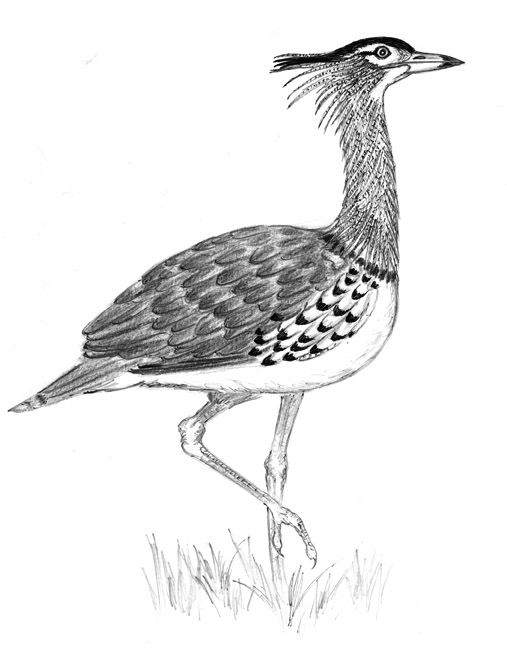
Dear Bird Folks,
I was at a party the other night and we were talking about the enormous amount of birdseed that birds can eat. This led to a discussion about which bird is the heaviest. Everyone was sure that the ostrich is the heaviest bird, but of course it can’t fly. No one seemed to know which is the heaviest bird that can still fly. What say you?
– Richard, Newport, RI
Oh, man, Richard,
I like talking about birds, but even I wouldn’t want to sit around all night having a conversation about birds with weight issues. And you say this was at a “party”? It must have been a pretty dull party. It sounds more like panel discussion on the BBC. But don’t worry; I’ll answer your question. I’m back to writing about birds again. In December I was too worried about the Mayans’ prediction to focus on birds. I spent the entire month making preparations for the world to end. And by “making preparations,” I mean not paying my credit card bills, ignoring much-needed yard work and letting the laundry pile up. Now I feel a little silly. Not only do I have a lot of credit card debt, but my yard’s a mess and I’m wearing my last clean shirt. I think I’m the only person who celebrated New Year’s wearing a T-shirt that said, “ALF for President.” Stupid Mayans. I’ll never trust them again.
You might think determining which is the heaviest flying bird would be easy. Researchers could simply gather up all the possible candidates, pop each one on a scale, and report which one is the tubbiest. But like predicting the end of the world, it’s not that simple. Some experts claim that the Mute Swan is the heaviest, especially the swans that feed on stale bagels in our public parks every day. Others claim that the fattest flier is the Great Bustard of Europe. (Yes, you read that right. There are birds called “bustards.”) But according to the folks at the Guinness Book of World Records, the title of the heaviest flying bird goes to Africa’s Kori Bustard, and who could argue with Guinness? Any organization that has certified such critical records as “the world’s largest whoopee cushion,” must know what it’s doing. They’re certainly more reliable than the Mayans.
Standing over four feet tall, Kori Bustards are large birds of the African savanna. They have thick necks, long chunky legs and elongated, tapered bodies, looking like bike helmets with legs. Some Kori Bustard tip the scale at forty-plus pounds, which makes them heavier than 14 Great Horned Owls, 225 Blue Jays or 1,723 Black-capped Chickadees. (But they are not nearly as heavy as the fruitcake your aunt gave you for Christmas.) Like our Wild Turkeys, bustards spend most of their time on the ground, only flying to escape danger. They are omnivorous birds, but their food of choice is insects. Bustards spend most of their time stalking through the African grasslands searching for such delectable goodies as locusts, grasshoppers and dung beetles. (Oh, yeah. Who doesn’t like to start each day with a fresh dung beetle?)
When it comes to breeding, Kori Bustards are, again, very much like Wild Turkeys. The males strut around and try to attract as many females as possible. After a bustard couple mates, the female sneaks away to lay the eggs, but the male doesn’t go with her. Instead, he goes off to find more females. Wow. He really is a bustard. Actually, the name “bustard” has nothing to do with the males’ behavior; it’s derived from Latin and an old French word meaning “slow mover.” Oddly, that title doesn’t really apply to these birds since they are able to move rather quickly. However, if you do say the word bustard, it is totally appropriate to say, “Pardon my French” afterwards.
Although the Kori Bustard is still a fairly common bird, their population has been dropping in recent years. Hunting and over-development are the main culprits. The other problem is that bustards are slow to reproduce. Unlike the hen Wild Turkey, which usually lays about a dozen eggs, the female bustard only lays a single egg or two each year. She then has to incubate the egg for three weeks and it’s another five weeks of growing before the chick is able to fly. During this time the young bustard is extremely vulnerable to predators. After all, it lives in Africa, where everything eats everything else. In an effort to help this species survive long-term, a few zoos have started captive breeding programs. The National Zoo in Washington, D.C. participates in one of these breeding programs, and I can see why. Washington produces more bustards than any city I know.
There you have it, Richard. Kori Bustards are the world’s heaviest flying birds. Although it be should be pointed out that it’s the male bustards that are the real titleholders. The females aren’t nearly as heavy. The ladies only weigh about twelve pounds. (All their hours spent at the Zimbabwe Curves have clearly paid off.) Be sure to share this information with your friends the next time you attend a party. I’m sure everyone will be thrilled to learn about bustards. Who knows, maybe you’ll even see me at the party. I’ll be the one wearing the ALF for President T-shirt.